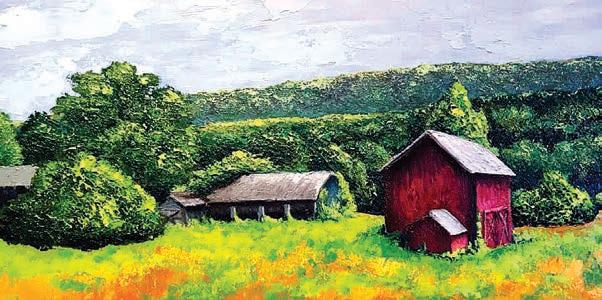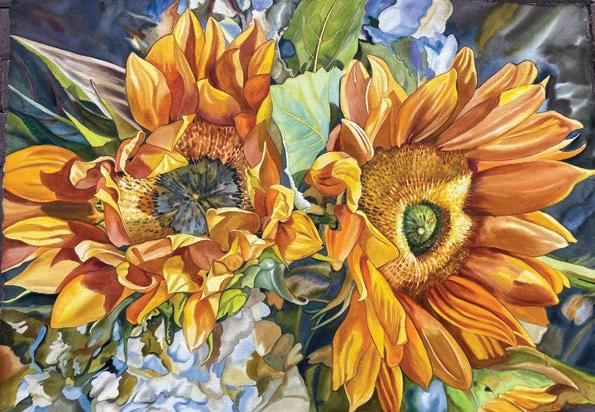5 minute read
ERIKA LARSKAYA ABSTRACT VISUAL ARTIST UPDATE 7.23
“When people ask why I make art, I often don’t know what to say. It’s very innate for me, like breathing. There isn’t a big and important message behind my work, but it has always been natural for me to express the cerebral and emotional parts of myself by creating artwork.” —Erika
Harryet Candee: How's life since our last interview? How is your art coming along?
Erika Larskaya: A lot has changed! Some unexpected family-related stuff inspired some new work. There are more works on paper and more paper in my paintings. Lots of paper! I’ve been working on a few new series. “Confinement” is the one that started the use of architectural drawing paper. That series is related to feeling imprisoned and trapped, both physically and by feelings and emotions. It led to the next series, “Breakaway,” where resilience and overcoming obstacles become the focus.
I love what you wrote in your last interview in 2021..." Weakness is a great thing, and strength is nothing. When a man is just born, he is weak and flexible. When he dies, he is hard and insensitive. When a tree is growing, it's tender and pliant. But when it's dry and complex, it dies.
Hardness and strength are death's companions. Pliancy and weakness are expressions of the freshness of being. Because what has hardened will never win." How is this relevant to your creative process? Can you show us an example of your art so that we can understand why this statement from the film Stalker has a connection?
EL: Every moment in life is a practice in learning to be more adaptable to various circumstances and experiences, including the creative process. It’s simply more painful otherwise to repress or avoid facing the world and ourselves. It is also unproductive; if we are too set in our beliefs, we don’t learn anything new and can’t see the possibilities. The understated elements in my work express the vulnerable side of life, with the delicacy of some materials, such as paper with holes and wrinkles or the spontaneous scribbled writing and marks with colored pencils. If you zoom in on any work from the “Confinement,” “Breakaway,” or “Por-
Larskaya
tals'' series, you will see the imperfections that speak to our experiences in life and of being human.
"Portals" is your most recent art exhibit at Five Points Annex in Torrington, CT. Tell us about the title, the space, and the selected body of work.
EL: I’m very excited to show up at Five Points Annex, and it’s such a great space to have here in downtown Torrington. This show is a collection of selected works from various series I’ve painted over the past two years. The title represents being open to alternate spaces, parts of reality in parallel existence to this moment. Each painting is its invitation to explore beyond the surface appearance of things and enter into more subtle and possibly uncharted territory, where complexity, impermanence, and emotional balance can be explored.
In our last interview before COVID, you defined yourself as an artist with this statement, "The abstract result allows for flexibility in how viewers relate to and interpret the artwork. I explore new ways of representing experiences through my artwork by experimenting with various mediums and supports." Do you still believe in this, and has anything changed or evolved with your work since then?
EL: I would say yes, I believe in this, and it definitely has evolved. While I always play with some representational style and sometimes enjoy drawing figurative work, I still feel that the abstract and non-representational way of communicating with the viewer is my preferred language. You can see it in all my latest works, including “Brooklyn 89,” which has a nice combo of my earlier and latest methods.
I still use acrylics, charcoal, markers, and anything that can make a mark on the surface, and now I have my architectural drawings. I have a great source for it from a friend’s construction business, so I go nuts tearing them apart and making holes, not thinking about the potential results. It’s fun; it’s liberating and also therapeutic! As soon as my method becomes too familiar, comfortable, and safe, I have to do something new. Using architectural drawing paper has given me a new perspective on the process. So far, it’s still challenging and fun.
One direction of exploration in your work has been working with and incorporating into your art crushed paper. Where are you now with that? What other materials have you found exciting and challenging to work with?
EL: I still have projects in progress with crushed paper, but the new obsession with architectural paper took over my mind and my entire studio. It’s everywhere, but I love it! I love the lines, the patterns, and the quality of paper itself. It tears and separates in layers just the way I like it. rides fear, and the health of our environment is a priority before immediate comfort." Now, both of us reading your statement, what thoughts can you add to this that reinforce or alter your thinking today?

Getting out to see other artists' work, have you found any new and inspirational female artists who share your interests in facing adversity and social restraints? What other artists in and around your community can you relate to and why?
EL: Everyone unafraid to break the rules and standards in the art scene inspires me. Some female artists who inspire me are Jen Abbott-Tillou, Shona Curtis, Karen Bonanno, Copper Curtis, and Sarah Conklin. All of them are fearless in expressing their perspectives on social issues. It’s not hard for me to relate to those artists, and our experiences of the world are very similar.
"I would redesign the nature of human behavior. I would make it so that compassion always overContinued on next page...


EL: I still think that way, in an idealistic sense, but I can also see that it might be impossible; it’s mostly wishful thinking. I think it would take a significant collaborative approach for us to make significant changes and alter the trajectory of our species toward a less destructive future.
Erika, tell us about your background. What took place in your life that led you to become an artist?
EL: I was always an artist, but living in Soviet Russia had its limitations. After moving to the US, I got serious about my art sometime in my 30s. I finally realized that I don’t need anyone’s permission to do what I want, so I just went for it and learned a lot of things along the way.
Do you find that things from your personal life tend to surface upon your canvas, even if it was not intended and a part of the original idea? Whether you plan to have them there or not, do you find they exist? It is funny how we have our secret symbols in our paintings, secret communication that may be viewed by the public but has a meaning only the artist understands and wants to keep to themselves. Can you give us a key to some of your secret symbolism, if any?
EL: There is really no secret. I write some thoughts and words that make sense at the moment. I like to add initials of people I know and various symbols representing things we deal with on a daily basis. I come up with it as I go through the process, and it depends on the painting. And yes, things come to the surface, and the symbols and words reflect that. I love working with my current choice of materials. It’s a perfect playground for all the subtle messages and expressions.
How will you be enjoying the summer?
The usual stuff for me is spending time at the beach by the ocean, hiking, and enjoying live music outdoors. I wish summer were nine months long; it’s truly my favorite time of year.
Website and other connections for viewing your art?

Website: www.erikalarskaya.art
Instagram: erika_larskaya_studio
Thank you, Erika!
"The Berkshires provided me with a natural backdrop for my paintings. I would look for areas of solitude and enjoy the natural colors of the seasons wherever I was. These images were memories I had a young boy, growing up in Lee. I will always remember them as some of my fondest days there."















